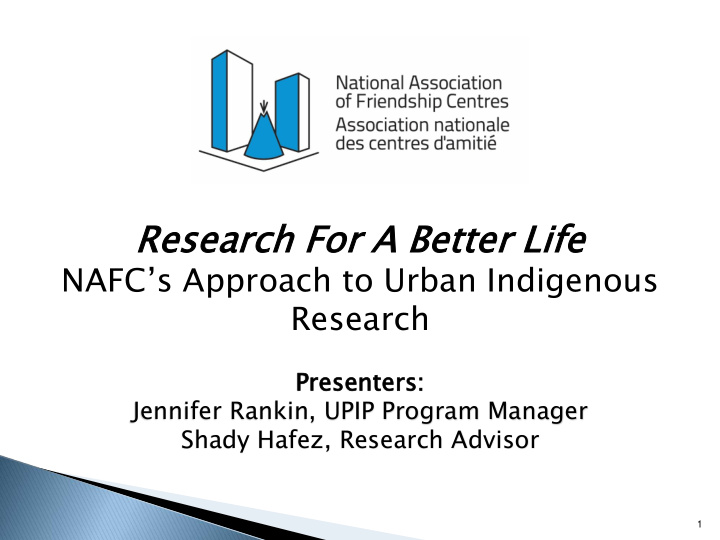



Researc arch h For or A Be Bett tter r Life fe NAFC’s Approach to Urban Indigenous Research Prese senters: nters: Jennifer Rankin, UPIP Program Manager Shady Hafez, Research Advisor 1
According to the 2016 Census, more then 1,022,000 or 61.1% of Indigenous people in Canada live in a Canadian city. Indigenous youth, including urban Indigenous youth are the fastest growing population in Canada. Urban Indigenous peoples generally fair better than on-reserve First Nations or Northern Inuit peoples, but their socio-economic status remains lower than that of their non-Indigenous neighbours Many of today’s Indigenous people migrate to urban centres from reserves for reasons such as employment, education or improved quality of life. While some urban Indigenous peoples have only known city life for 2, 3 or even 4 generations. 2
Established in 1972. the NAFC is democratically governed, and accountable to its membership. The NAFC’s mission is, “to improve the quality y of life for In Indige genous nous peoples in an urban n envi viro ronmen nment by supporti ting ng se self-dete etermin ined activities ities which ch enco cour urag age equal l access to, a and participa ipati tion on in, Canadian ian Society; y; and which ch respect pect and streng ngthen then the increa reasin ing g empha hasis is on In Indige genous nous cultural distinctiveness.” 3
Friendship ndship Cent ntre res • With over 2,700 staff working in Centres across the country, Friendship Centres are one of the largest employers of Canada’s urban Indigenous population. With a current physical infrastructure of 238 buildings in communities and cities from coast to coast to coast. • Friendship Centres offer programs and services to all urban Indigenous people, regardless of status, for housing, child care, health, education, employment, culture and language, family, economic and community development and justice, all wraparound services that are crucial for poverty reduction. 4
Friendship Centres and urban Indigenous organizations are using research to leverage funds to access or continue to access funding for programs and services, create better partnerships with other service organizations, researchers, community members and government, and create research that feeds back into the community to improve the quality of life for the urban Indigenous population. 5
NAFC Research Framework Development of Research Ethics Internal Research Policy Research Screening Tool Research Policy Statement Research Ethics Board at NAFC Training Modules (increased capacity) 6
Support communities to ethically and meaningfully engage in community driven research by Building and supporting community capacity to partner in Pathways research. Building capacity of community to turn research into action by supporting the development and implementation of community specific knowledge mobilization plans. Building researcher capacity to understand and respect the urban Aboriginal research environment. Brokering and supporting research relationships between Friendship Centres and Implementation Research Teams (IRTs). Promoting urban Aboriginal research opportunities among post secondary students. Supporting and facilitating the scale-up of interventions. 7
UAK AKN N : R : Resea earch rch For r a a Better tter Li Life fe The UAKN is a research network with a focus on urban Indigenous concerns. Our goal is to contribute to a better quality of life for Indigenous peoples living in cities and towns by filling knowledge gaps in urban Indigenous research, programming and public policy. Goal: Research aimed at fostering “ mino-biimaadiziwin ” – the good life for urban Indigenous peoples This is achieved through funding high-quality, policy relevant that brings together perspectives from urban Indigenous communities, academia and government. 8
Back ckground ground of the UAKN KN The UAKN is a multilateral partnership between urban Indigenous community-academia- government. Since 2007, the partnership development has been led by the National Association of Friendship Centres (NAFC) and Indigenous Affairs and Northern Development Canada (AANDC). SSHRC Partnership Grant – 2.5 million over 5 years (2012-2017) In 2016 we have 80 formal community/academic/government partners (national/regional) with expectations to add more partners in coming years, and many more informal partners. The UAKN Secretariat is located at the NAFC, but is not exclusively for Friendship Centres, we have a variety of community partners. 9
Over 80 regional research projects and counting! Over 60 students involved to date! 80 verified partners including co-applicants (44), collaborators (2) and partners (34). 10
11
12
13
14
NAFC has been granted institutional eligibility to hold the funds for the next SSHRC grant Continue with a community-driven and led approach Goal: Further support and build research capacity in Friendship Centres and urban Indigenous communities Not about excluding academic and government partners Looking for partners and letters of support in the renewal stage 15
16
Recommend
More recommend